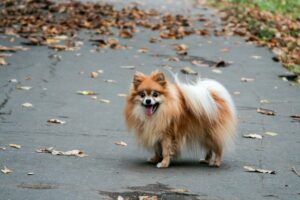 |
| Photo by: twenty20 |
The Pomeranian, this little dog with a fox-like appearance will surely touch you with its full coat and charming face. On the other hand, you should be aware that behind this endearing physique may hide a dynamic, sensitive or even temperamental dog. His education will therefore have to start young and his need for expenditure will also have to be channeled to avoid any overflow.
The result of a long and noble history, it took only a few decades to earn him the nickname “concierge dog”. We speak well of this alert and very affectionate dog, whose beauty seduced the greatest characters of the 19th century! What if we tried to overcome prejudices to find out who is really hiding under this adorable ball of fur?
It’s hard not to fall for such a cute face. This little doggie is loving with his masters, but also very playful. You won’t get bored with him between cuddles and games. Find out everything you need to know about this cute and beautiful dog.
Brief background:
The Pomeranian is considered a dwarf Spitz-type dog. The first breeding programs date back to the 19th century in Germany, more precisely in the Pomeranian region. It should be noted that the dogs of the time were rather large. Queen Victoria became infatuated with the breed, and breeders used her dogs to reduce the size of the breed even more and produce the dwarf dog we know today.
There is no doubt that the German Spitz is the ancestor of the charming little Pomeranian. In those days, dogs were chosen for their small size and the bright colors we know today, rather than the grey or white, the standard colors of the Spitz. The Pomeranian has always been considered a companion dog with a small guard dog side.
In the 1800s, the Pomeranian was not as small as it is today. At the time, it was one of Queen Victoria of Germany’s favorite pets. Breeders used the Queen’s dogs to reduce the size of the breed and produce a dwarf dog.
The Pomeranian is truly a dwarf dog, ideally measuring 8 to 11 inches at the withers and weighing only 3 to 7 pounds (1 to 3 kg). They often reach their adult size at 7 to 10 months of age.
The Pomeranian is easily recognized by its beautiful, fluffy coat with abundant undercoat, bright-eyed fox’s head and sharp ears that are always alert. Pomeranian are rather square in stature, with a very bushy tail that is erect at the root, folded forward and rolled over the back. They have an imposing neck with a large collar, a slightly round head and a distinctive muzzle. This completes the description of a dog that could face the snows of northern Germany.
Pomeranian come in a wide range of colors. The breed is most often associated with a rich red, but the color palette is very broad, ranging from black to white, orange to sand and all shades.
 |
| Photo by: twenty20 |
Character:
The Pomeranian is a generally playful and friendly little dog. They don’t seem to understand that they are out of their league and sometimes attack large dogs, or at least threaten them by barking!
This active small dog needs to exercise every day, even just a walk around the block. Pomeranians are very intelligent and rank well in obedience competitions, despite a slight tendency toward independence. As they get older, their character softens, making them ideal companion dogs.
Because of their alert nature, Pomeranians often make good watchdogs and may have a tendency to bark excessively. Pomeranians generally get along well with children, but it should be explained that because of their small stature, Pomeranians are more sensitive than larger dogs.
 |
| Photo by: twenty20 |
Daily Life:
Pomeranians are generally prone to becoming fat, although some are “thin-mouthed”. They don’t tend to become obese, probably because of their active temperament. Their double coat requires regular maintenance once or twice a week, as well as daily sessions at molting time.
Despite their small size, Pomeranians need to exercise regularly, and training is successful. They are highly intelligent and enjoy learning to do tricks and putting on a show. Pomeranians generally live well with other pets, but they must be vigilant if they come into contact with a large dog that could accidentally injure them. Pomeranians get along fairly well with the children they were raised with and may be reserved with others. Children should be reminded that a small dog like the Pomeranian is more sensitive than a large dog and should not be left unattended with children.
Because of its alert nature and tendency to bark, the Pomeranian is an excellent guard dog. Their alertness and small size make them a very good companion for the elderly.
An expensive plush toy
These little dogs are worth their weight in gold! Indeed, to hope to welcome a Pomeranian into your family, you will have to count about 3000 $ just for its acquisition. If you think you’ll fall in love with this little plushy, don’t forget to count the additional costs of the vet, grooming, food and equipment.
On average, Pomeranian generally cost between $500-$1,500. According to NextDayPets, the average price of Pomeranian sold is $900. The price for Pomeranian with top breed lines and a superior pedigree increases steeply. For these, you can expect to pay anywhere from $3,000 up to $10,000, depending on the breeder.